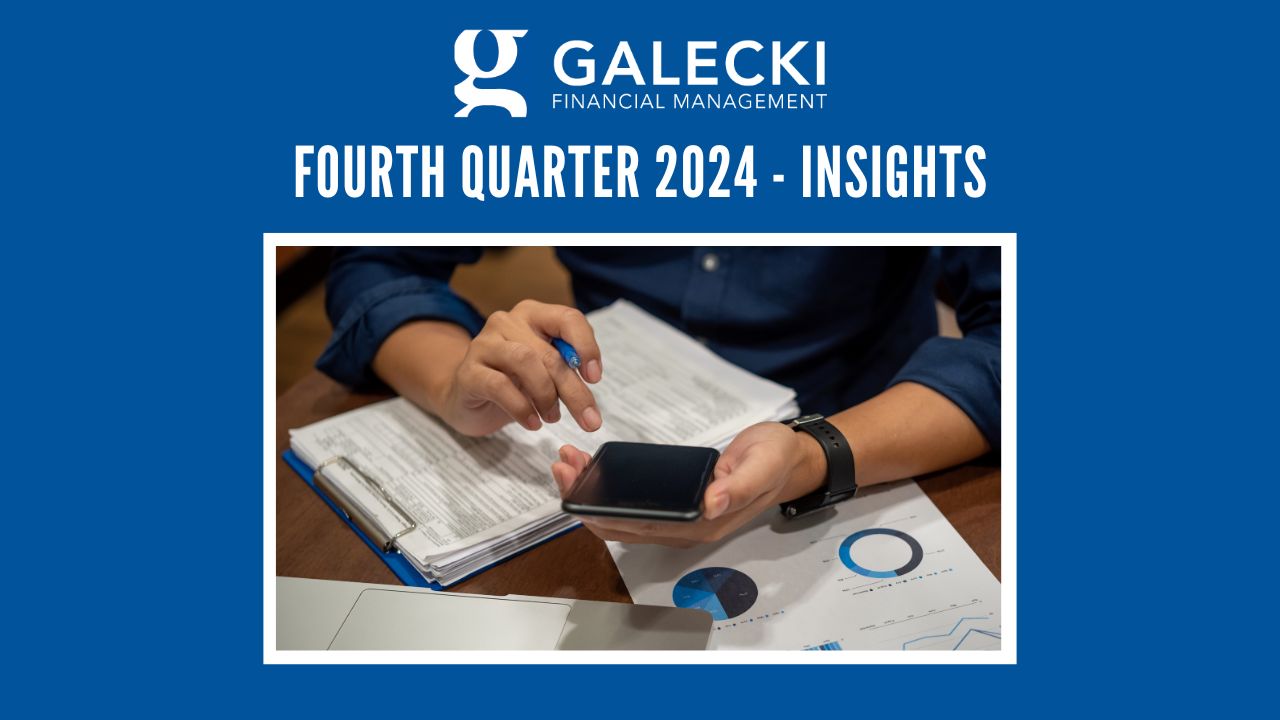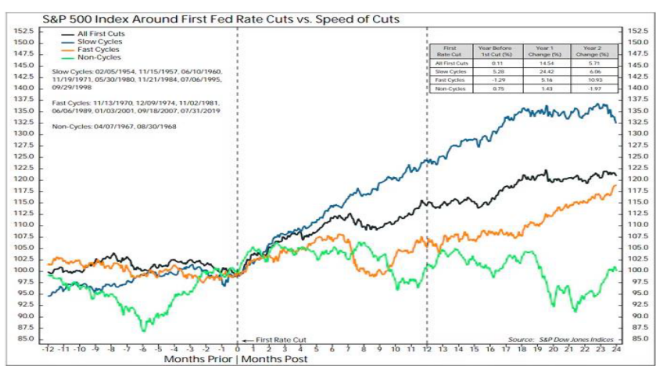

Index Returns
The third quarter delivered solid returns across nearly all asset classes. The S&P 500 saw an increase of 5.89% powered by value stocks. The S&P 500 Value Index was up 9% in the quarter. The Russell Midcap Index surged 9.21% in the quarter while the small caps as measured by the Russell 2000 Index also advanced by 9.27%. The Dow Jones Industrial Average registered a gain of 8.72% over the last three months.
Developed International stocks outpaced the S&P 500 in the quarter with a gain of 7.26%. Hong Kong gained 24% while Singapore advanced by 17%. Emerging markets also were strong with a gain of 8.72%. This was fueled by China’s bounce of 23.64% in the third quarter. Commodities dropped 5% in the quarter but are still positive on the year. Real Estate surged 17% in the quarter and is now up nearly 14% on the year.
Bonds roared to life with the Federal Reserve cutting rates by 50 basis points. The Barclays Aggregate Bond index advanced 5.2% in the quarter. Global bonds are now up 8.73% on the year.
Economic Review and Outlook
Economic growth has been relatively strong so far this year. Second quarter GDP came in at an annualized rate of 3.0%. Consumer spending is slowing and household debt is increasing. Credit card debt has risen significantly recently suggesting that households are stretched too thin. We do think the economy will continue to grow in the final quarter of this year, but we might be setting the stage for a much softer 2025.
The Federal Reserve cut the Fed Funds Rate by 50 basis points last month. Inflation is hovering around 2.5% annually, which is close to the Fed’s target of 2.0%. The Fed has indicated that they will cut two more times this year and 3-4 times in 2025 in an attempt to cushion the economic decline and provide a soft landing. This plan relies on inflation remaining where it is and not jumping to higher levels.
The Leading Economic Index declined 0.2% in August to 100.2 following a 0.6% decline in July. Industrial Production increased 0.8% in August. The Capacity Utilization rate (which measures how much slack is in the economy) moved up to 78.0% which is in line with it’s long-term average.
Non-farm payrolls rose by 254,000 in September and the unemployment rate remains at 4.1%. Weekly unemployment claims were 258,000 for the week ending October 5, 2024. The 4-week moving average is at 231,000. There are 8 million job openings in the U.S. which is down from 10.1 million in June. It is important to remember that the unemployment rate is a lagging indicator. Weekly unemployment claims are a better real-time indicator and this number has been rising. We are beginning to see some softening in the labor market. The unemployment rate is now 0.7 percentage points higher than the low of 3.4 last year. We have never seen an increase of 0.6 or more and not been in a recession. We could see more weakness in 2025.
Manufacturing registered 47.2% on the ISM PMI index in September. This was in line with August and has now been in contraction territory for 22 out of the last 23 months. The New Orders Index came in at 46.1% which was 1.5 percentage points higher than August. The ISM Services index was at 54.9% in September which was 3.4 percentage points higher than August. The Business Activity Index came in at 59.9% which was 6.6 percentage points higher than August. New Orders for the service sector came in at 59.4% which was 6.4 percentage points higher than August. The Employment index was at 48.1% and represented the first contraction in the last three months.
The JPM Global Manufacturing PMI was at 52.3 in September down slightly from the 52.8 mark in August. The Euro area is at 48.9 while Emerging Economies are growing at 52.1.
Equity and Bond Markets
Equity markets in the third quarter finally got a push from non-Mega-Cap companies. Value stocks and smaller stocks began to move higher. We mentioned earlier that the Federal Reserve made a cut to the Fed Funds rate in the last quarter. What does this mean for stocks over the next year? Going back to 1957, stocks are up 14.54% on average on the one-year anniversary of the first cut and 5.7% in the second year. However, the pace of rate cuts has made a difference. In fast-cut cycles, the first-year return dropped to 5.16% and 10.93% in the second year. In slow-cut cycles, the returns were 24.42% and 6.06%.
This can probably be explained by the fact that fast-cut cycles have occurred during larger economic turmoil periods, while slow-cut cycles tend to be centered around just a slowing economy. It is too early to determine how aggressive the Fed will be during this cycle, but historically speaking stocks like a slower approach.

International stocks made a good run in the third quarter and outpaced the S&P 500. They remain very cheap from a historical perspective. The P/E ratio for the MSCI EAFE (Developed Markets) index is at 14.4, which is very near the 15-year average of 13.8 times earnings. The P/E ratio for MSCI EM (Emerging Markets) index is at 12.5, which is also quite near the long-term average of 11.4 times earnings. We believe that international equites have room to grow and remain a critical component of a diversified portfolio.
We have a major election in November. The uncertainty that this election will bring could be accompanied by some short-term market volatility. It will probably take a week to determine the actual outcome from the elections. It is important to remember that these are all short-term concerns, and we are investing in companies for their longterm growth potential. Businesses will adapt and find a way to grow, regardless of political outcomes.
For fixed income, if rates do indeed decline over the next 12 months, existing bonds will increase in value. This will help the bond side of our portfolio, as well as ease some of the pressure on the housing market.
Portfolio Management
The Investment Committee continues to monitor the economy, the market, and the allocations. The economy is still growing, and consumers are remaining resilient despite the headwinds. It is likely that consumers will continue to spend as we enter a seasonally strong period for consumption. Because we are seeing some cracks in the labor market, we do question whether this can continue into the second half of 2025.
We have been saying all year that the Mega Cap stocks in the U.S. look expensive, but there are still plenty of opportunities out there. Indeed, we are seeing value stocks surge. Given the strong earnings improvement from these value companies, we think they will continue to outperform over the next 12-18 months.
The fixed income side of our portfolios finally contributed in a positive manner over the last three months. Given the projection for rates over the next year, bonds should continue to provide income, capital preservation, and even price appreciation, in this declining interest rate environment. We will continue to monitor the economic and political landscape, to make sure that we are properly positioned and diversified.
Any changes that we do make will be tactical in nature as we will not try to “time the market”. We are long-term investors and will do our best to ignore the short-term volatility we could see over the next six months.
Financial Planning
The Tax Cuts and Jobs Act was enacted in late 2017. This legislation made sweeping changes to personal income taxes, corporate taxes, and Federal estate taxes. These tax laws will “sunset” or expire at the end of 2025. In 2026, the tax code is scheduled to revert to the rules in place in 2017. Congress can always enact new laws between now and the end of 2025, but for now we are planning for this sunset to occur as scheduled.
What does this mean for you? On the personal income tax side, this will likely mean higher tax liabilities across the board for taxpayers. The top Federal income tax bracket will increase to 39.6% from 37% today. The income brackets will also shrink in size meaning more income will be taxed at a higher rate. The standard deduction will be lowered, which means more taxpayers may itemize their deductions again. Itemized deductions include expenses such as mortgage interest, taxes (state, local, real estate, and personal property), medical expenses, and charitable donations.
If you anticipate a large income event in the next 2 years, it may be beneficial for that event to occur prior to December 31, 2025. Of course, all financial situations are vastly different, so it is always best to speak with your trusted Fee-Only Financial Advisor and tax expert before finalizing any decisions.
On the estate tax front, currently an individual may pass $13.6 million either during life or at death to their heirs free of estate taxes. This doubles to $27.2 million for married couples. If the Tax Cuts and Jobs Act expires as planned, this estate exclusion will be cut in half. For our purposes, we will assume this is $7 million per individual, $14 million for a married couple.
If your total estate is over or nearing $14 million, there are actions you can take to lower your Federal Estate taxes.
Before implementing any of these changes, you should have a conversation with your advisor to ensure these are best for your situation.
The “easiest” way to lower your taxable estate is to begin making gifts during your life. In 2024, you can give $18,000 to any person without incurring any gift taxes. This is the annual gift exclusion. For a married couple, this is $36,000. So, you could begin gifting funds to your children or other heirs each year. If you give $36,000 to 5 people over 5 years, you have moved $900,000 out of your taxable estate.
If you don’t want to give gifts outright, you could gift into a 529 plan for educational purposes. Any assets contributed to a 529 plan stay in your control as the owner of the account but are counted as a gift to the named beneficiary.
Gifts to charity are passed free from estate taxes. You could consider leaving a percentage of your estate to charity or making charitable donations during your lifetime. If you are over age 70.5, you can complete a Qualified Charitable Distribution (QCD) from your IRA. A QCD counts toward satisfying your Required Minimum IRA Distribution (RMD). The maximum QCD in 2024 is $105,000. QCDs are free from income taxes as well.
Another common estate tax strategy is called a Grantor Retained Annuity Trust (GRAT). This strategy deserves its own section to properly explain, but the overall idea is to gift the appreciation out of your taxable estate. The appreciation is gifted to the individuals named as beneficiaries of the Trust. Let’s assume you establish a GRAT with $2 million. Over the course of the next X years (determined by the Trust), you will withdraw your initial $2 million back out of the GRAT. This is where the term annuity comes in. No annuity products are actually purchased for this strategy. If that initial $2 million grew to $2.5 million over X years, the remaining $500,000 in the GRAT at the end of the term is distributed to your heirs.
An upcoming change in tax laws can be daunting. Don’t get caught up in the scare headlines that will ramp up next year trying to convince you immediate action is needed. If you have specific concerns about your income or estate tax situation, speak to your trusted Fee-Only Financial Advisor.
Company News
Our office is undergoing a renovation in the 4th quarter! Our lobby, reception area, conference rooms, and client bathroom are being remodeled. We are excited for this project to begin and can’t wait for our clients to see our new look in 2025.
Construction will begin the week of Thanksgiving. We hope to have the project completed by the end of December. We will be unable to hold meetings in our office during this time. If you have a meeting currently scheduled with your advisor during this timeframe, you’ll be hearing from us soon about rescheduling, holding the meeting virtually, or other meeting options.
Along with the overall renovation, Phresh Laundry, a local artist, is creating custom pieces for our space. If you are local to Fort Wayne, you have undoubtedly seen his work around our area. He has completed downtown murals, collaborated with our public library, and is involved in countless other projects in Northeast Indiana. Here is a sneak peak of one of our pieces.
We will be posting about our renovation on our social media channels. Follow along on Facebook and LinkedIn.

